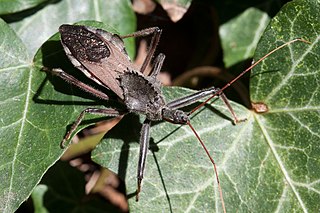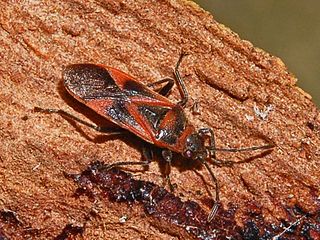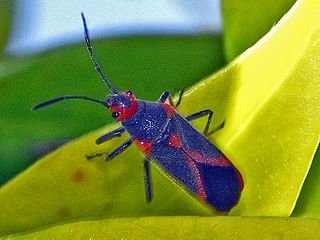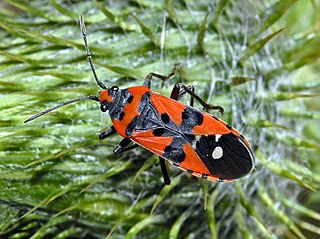
Pentatominae is a subfamily of Pentatomidae, a family of shield bugs. This subfamily is the largest one within the Pentatomidae, having 4937 species classified in 938 genera. Species in this subfamily are phytophages and several of them are considered agricultural pests. Some invasive pentatomines such as Halyomorpha halys and Bagrada hilaris have been considered household pests. Higher systematics of the group have been revised by Rider et al.

The Lygaeoidea are a sizeable superfamily of true bugs, containing seed bugs and allies, in the order Hemiptera. There are about 16 families and more than 4,600 described species in Lygaeoidea, found worldwide. Most feed on seeds or sap, but a few are predators.

The Lygaeidae are a family in the Hemiptera, with more than 110 genera in four subfamilies. The family is commonly referred to as seed bugs, and less commonly, milkweed bugs, or ground bugs. However, while many of the species feed on seeds, some feed on sap (mucivory) or seed pods, others are omnivores and a few, such as the wekiu bug, are carnivores that feed exclusively on insects. Insects in this family are distributed across the world. The family was vastly larger, but numerous former subfamilies have been removed and given independent family status, including the Artheneidae, Blissidae, Cryptorhamphidae, Cymidae, Geocoridae, Heterogastridae, Ninidae, Oxycarenidae and Rhyparochromidae, which together constituted well over half of the former family.

Nysius is a genus of false chinch bugs in the family Lygaeidae. At least 100 described species are placed in Nysius.

Arilus, or wheel bugs, is a genus of true bugs in the family Reduviidae, subfamily Harpactorinae and tribe Harpactorini. Most species are found in the Americas.

Arocatus roeselii is a species of lygaeid bug.

Heterogastridae is a family of lygaeoid bugs consisting of about 20 genera and more than 100 species.

The Blissidae are a family in the Hemiptera, comprising nearly 50 genera and 400 species. The group has often been treated as a subfamily of the Lygaeidae but was resurrected as a full family by Thomas Henry (1997).

Spilostethus is a genus of bugs in the family Lygaeidae. Most species in this genus are from the Palearctic and Oriental regions.

Dysdercus is a widespread genus of true bugs in the family Pyrrhocoridae; a number of species attacking cotton bolls may be called "cotton stainers".

Lygaeinae is a subfamily of ground bugs in the insect family Lygaeidae.

Arocatus is a genus of bugs in the family Lygaeidae.

Lygaeus is a genus of seed bugs in the family Lygaeidae. There are more than 60 described species in Lygaeus.

Arocatus melanocephalus, the elm seed bug, is a true bug in the family Lygaeidae. The species was initially described by Johan Christian Fabricius in 1798, and Maximilian Spinola designated it to be the type species of the genus Arocatus in 1837. This bug is native to Europe but has been introduced to North America.

Geocoridae is a family of big-eyed bugs in the order Hemiptera. There are more than 290 described species in Geocoridae.
Amulius is a genus of Asian bugs in the family Reduviidae. It has been placed in the tribe Ectinoderini: the 'Oriental resin bugs'.

Arocatus rusticus, the swan plant seed bug, is a species of seed bug in the family Lygaeidae. It is found in Australia and New Zealand.

Pachygrontha is a genus of seed bugs and allies in the family Pachygronthidae. There are more than 30 described species in Pachygrontha.

















